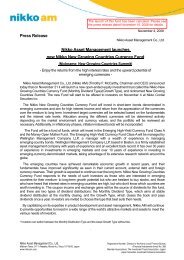The Global Currency Investor A Quarterly Analysis of 50 World ...
The Global Currency Investor A Quarterly Analysis of 50 World ...
The Global Currency Investor A Quarterly Analysis of 50 World ...
You also want an ePaper? Increase the reach of your titles
YUMPU automatically turns print PDFs into web optimized ePapers that Google loves.
IntroductionIn last quarter‟s currency outlook we highlighted how currency markets remained in theshadow <strong>of</strong> the 2008 global financial crisis. This became even more apparent in Q3 2011as the markets gyrated between „risk on‟ „risk <strong>of</strong>f‟ trades, sometimes in a violent fashion.<strong>The</strong> backdrop <strong>of</strong> the European sovereign debt crisis, ongoing political gridlock in respectto US fiscal deficit reduction and signs <strong>of</strong> a slowdown in global economic growth were theprime causes <strong>of</strong> concern. However, within currency markets significant developmentsadded to the uncertainty: Firstly, various emerging countries became anxious about thestrength in their currencies and the long-term damage this might cause. Secondly, theSwiss National Bank surprised the markets with a strong commitment not to allow theSwiss Franc to rise above a certain level against the Euro. This drawing a line in thesand has been an unequivocal success to date. However, these developmentsheightened a growing belief that adhering to fully floating exchange rates when suchlarge short-term capital flows swirl around the global financial system can have seriousramifications for domestic economic prospects.<strong>The</strong>re is little doubt the global economy remains in a transition period and this is causingstrains in currency markets in two ways: Firstly, the demand for yield or safety is pushingexchange rates to levels which can cause damage to the underlying domestic economy.Secondly, many emerging markets, although benefitting from strong macro fundamentals,do not have the breadth and depth within their capital markets to cope with inwardinvestment flows on such a large scale. For this reason, although we remain veryconstructive on the secular outlook for many emerging market currencies, recent eventsare a timely reminder they will remain susceptible to high volatility due to the lack <strong>of</strong>breadth and liquidity within many <strong>of</strong> their financial systems.This continues to make currency forecasting a hazardous occupation in the short-termand is why many currency strategies which are reliant on momentum/carry themes havestruggled during 2011. Overlay this dimension with the added hazard <strong>of</strong> politicalinterference and the outcome will remain one <strong>of</strong> uncertainty for some time to come.Stuart KinnersleyChief Investment OfficerNikko Asset Management Europe2Confidential – not for redistribution. This material must be read in in conjunction with the “Important Information” statement provided on the last herein. page.





